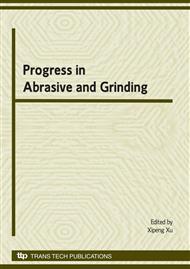p.77
p.85
p.97
p.103
p.113
p.123
p.131
p.137
p.143
Applications of Contact Length Models in Grinding Processes
Abstract:
The nature of the contact behaviour between a grinding wheel and a workpiece in the grinding process has a great effect on the grinding temperature and the occurrence of thermal induced damage on the ground workpiece. It is found that the measured contact length le in grinding is considerably longer than the geometric contact length lg and the contact length due to wheel-workpiece deflection lf. The orthogonal relationship among the contact lengths, i.e. lc2 = (Rrlf)2 + lg2, reveals how the grinding force and grinding depth of cut affect the overall contact length between a grinding wheel and a workpiece in grinding processes. To make the orthogonal contact length model easy to use, attempts on modification of the model are carried out in the present study, in which the input variable of the model, Fn’, is replaced by a well-established empirical formula and specific grinding power. By applying the modified model in this paper, an analysis on the contributions of the individual factors, i.e. the wheel/worpiece deformation and the grinding depth of cut, on the overall grinding contact length is conducted under a wide range of grinding applications, i.e. from precise/shallow grinding to deep/creep-feed grinding. Finally, using a case study, the criterion of using geometric contact length lg to represent the real contact length lc, in terms of convenience versus accuracy, is discussed.
Info:
Periodical:
Pages:
113-122
Citation:
Online since:
January 2009
Authors:
Keywords:
Price:
Сopyright:
© 2009 Trans Tech Publications Ltd. All Rights Reserved
Share:
Citation:


